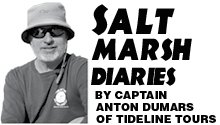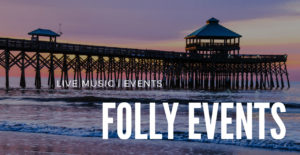You No-Good Dirty, Double-Crossing Rat
 As the northeast wind raged outside, I couldn’t stop thinking about the rat. Desperately, I need to visit the little island to check. Just three days prior, I found a rat’s nest inside the battery box. I also found the communication cables chewed in half.
As the northeast wind raged outside, I couldn’t stop thinking about the rat. Desperately, I need to visit the little island to check. Just three days prior, I found a rat’s nest inside the battery box. I also found the communication cables chewed in half.
This story started four years ago when the image of new Folly bridges existed only as blueprints. The newer, taller bridge would have fewer, but larger, columns. Larger columns would support longer girders on the new bridges, giving much more space underneath for passing boats. Fewer columns would also disrupt less of the natural tidal flow in most locations. Bridge specifications placed two bridge support columns directly into the mouth of what’s now casually called “Stringer Creek.”
On the northern side of the Folly River Bridge, a creek sprouts off to the northeast. This formerly un-named creek became the subject of an ecologic impact study once word got out about a potential flow restriction. Ecologic changes due to these potential flow restrictions prompted biologists from the South Carolina Department of Natural Resources (SCDNR) to take notice.
In response, they established monitoring points in several locations up the creek. As a geologist, I was asked to aid the study by monitoring hydrologic changes. Prior to any construction, baseline data were collected for comparison to post construction conditions. Since these initial baseline measurements were collected, three annual field sessions have been completed.
How does one go about collecting hydrologic data? Hydrology refers to water flow in a natural stream. Factors affecting flow include a stream’s depth and width (cross sectional area) and the flowing water’s speed. Multiply these factors together and you get volumetric flow rate.
I needed an instrument that would calculate volumetric flow rate and integrate it through several tidal cycles. An Internet “build your perfect instrument” keyword search led me to the proper tools and place to get them.
Conducting salt marsh fieldwork means getting wet and muddy. Often fieldwork requires schlepping heavy, robust equipment into and out of a boat, then across the marsh and into the creek. With field location selected, work began.
To measure the creek’s cross sectional area, I set up a rotating contractor’s laser level, then referenced it to the known elevation of a bronze benchmark on the old bridge. Horizontal cross-creek distance was measured using a 100-foot tape. Creek bed elevation was measured at fixed horizontal intervals across the width of the creek.
At each interval, I extended a laser detector-topped stadia rod up until it encountered the rotating laser beam. From this, I measure from the beam’s known elevation down the stadia rod to determine creek bed elevations along the transect.
Once established, cross-sectional area was fed into the instrument’s operating software. The instrument was then placed into the creek and turned on. After several days of measurement, data were downloaded and equipment retrieved.
Now in the fourth annual data collection session, I’ve run into a natural hazard … rats. The fifth day after deploying the equipment, I took a boat ride out to download data and check conditions. I waded through the pluff mud then onto the island. I arrived at my site, unpacked the laptop, and lifted the lid off the battery box. Here I found green grass and plastic bag debris in a previously empty space. I began cleaning out the debris. The second handful contained a big live rat.
I jumped and screamed. The rat ran away into the brush. While nesting in the battery box, the rat chewed my communication cables in half, halting any data collection. After finding this, I packed up my laptop and retreated to the boat.
Five days later, I returned. As if I were General McArthur returning to Leyte, I waded ashore armed with repair parts. I spliced the chewed cable, fired up the laptop, and prayed to the electron gods.
“Success” read the text line.
Communication established. Proceed to collect data. With instrument re-deployed, I packed up my gear and asked the rats out loud to please make their home elsewhere.
Contact Captain Anton Dumars to schedule your personal romp through the pluff mud. www.Tidelinetours.com, saltmarshadventure@gmail.com.

